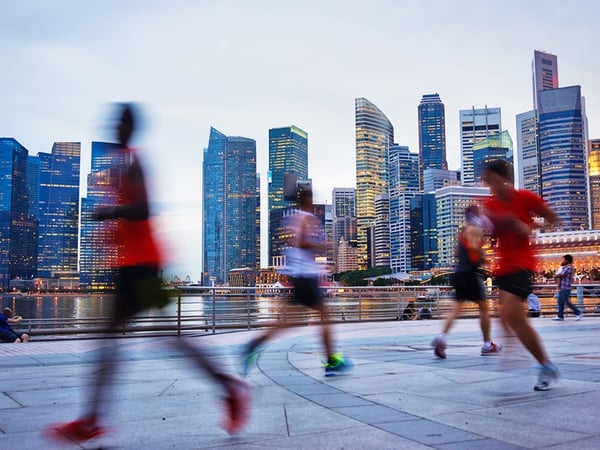The shift worker's guide to staying active


In today�s economy, shift work is becoming more prevalent than ever. What used to be a work arrangement unique to security, healthcare and hospitality industries is now becoming the norm in other industries.
Thanks to our globalised economy and advanced technologies, the ecommerce industry is booming, and companies are striving to speed up delivery time. This results in more shipping and logistic manpower needed 24 / 7 to deliver orders. Call centre representatives are also working round the clock to help with any issues too.

Shift workers across industries, rotate between day and night shifts to keep operations going. Unfortunately, shift work, particularly night shifts, can be very disruptive to a person�s health and wellbeing. Hence, it is essential that shift workers stick to an exercise regime.
Why exercise? You may ask. And how? Especially since a shift worker�s schedule is inconsistent. We will help to answer these questions in this guide.
How does shift work affect health?

Workers involved in rotating shift work experience daily stress and fluctuations of biological functions. For example, in night shift workers, staying awake at night and being exposed to light suppresses melatonin production, a hormone which signals the body to prepare for sleep. Apart from the disruption in the circadian rhythm, it can also result in a lowered production of melatonin in the body, which may increase the risk of heart attacks and strokes as melatonin has shown to reduce blood pressure and improve blood coagulability in some studies.
Continuous disruption of the circadian rhythm and chronic lack of sleep can also lead to other health complications such as:
- Psychological and mental health
Persistent disturbance of circadian rhythms and sleep deficits may lead to chronic fatigue, chronic anxiety and/or depression. - Gastrointestinal disorders
Shift workers often change their timing and frequency of eating, and the changes in eating and sleeping times could cause problems such as constipation, indigestion and stomach ulcers.
? READ: Nutrition strategies for shift workers
- Cardiovascular and metabolic disorders
Mismatch of circadian rhythms, lack of sleep, changes in eating patterns (i.e. quality and timing of meals and frequent snacking) and higher stress levels could lead to obesity, high cholesterol, and high blood pressure. Some studies have also shown that shift workers have an increased resistance to insulin at night, and that type 2 diabetes were common among workers undergoing rotating shift work.
? READ: Sleep strategies for shift workers
- Lower fertility and miscarriage in women
The menstrual cycle of female rotating shift workers may be affected along with disruption in circadian rhythm. Studies have shown a higher rate of altered menstrual cycle, premenstrual syndrome, and menstrual pains in groups of women shift workers, such as nurses, air crews, and blue-collar workers. Some studies also reported a higher incidence of miscarriage and impaired fetal development.
All this creates a situation where workers become less efficient at work due to their impacted health and energy levels. They are more likely to make errors or get into accidents due to sleepiness and fatigue. In addition, poor health results in more workers taking medical leave to recuperate.
How can exercise help shift workers?

Exercise can help to minimise the negative health impacts of shift work as it has various benefits on the body:
- Although the exact mechanisms are unknown, exercise could help us sleep better and improve energy levels. Exercise triggers an increase in body temperature and the drop in temperature after exercise may promote faster onset of sleep. Exercise may also reduce insomnia by decreasing arousal, anxiety and depressive symptoms.
- A research has shown that exercise had an effect in increasing gut microbes that help to reduce inflammatory diseases as well as type 2 diabetes, obesity, and heart disease.
- Aerobic exercise helps individuals improve cardiovascular health by enhancing oxygen delivery and promoting a long-term anti-inflammatory effect, which helps to counter the inflammatory effects typically seen in cardiovascular Exercise also decreases cardiovascular risk factors such as high blood pressure and obesity

Incorporating exercise into the schedule
Here are some tips by our Active Health Coach, Mr Munir, on how a shift worker can fit exercise into his or her schedule:
- If the workplace is near home, one can consider walking or running to work instead of using public transport. Depending on the distance, investing on a bicycle can be an option too.
- Should exercise be done before or after your shift? It can be challenging to exercise after a gruelling 12-hour shift. Hence, it is recommended to sleep right after the shift and then wake up to do some exercise. One can also exercise before work to energise for the day.
- Head to one of the ActiveSG gyms located islandwide. Most of them are open from 7am, and some close at 12.30am. If the timings do not suit your work schedule, consider gyms that operate 24 hours.
- Consider signing up for exercises classes with a friend to ensure commitment and accountability. This can be a great motivational boost too.
- Have an exercise diary to plan and include exercise on off days. If you fail to plan, you plan to fail!
- Take short �movement breaks� if your work allows you to. This can be as simple as walking or doing some bodyweight exercises for 5-10 minutes after period of prolonged seating or staying in the same position.

Ultimately, finding something enjoyable and easily accessible is important for a busy shift worker. Having a conducive and convenient exercise plan can shape behaviours and ensure sustainable habits and healthy work-life balance.
For more useful resources and workshops to Move Better, Eat Better and Rest Better, check out these links below:
? Check out: Stretches and workouts at work
? Check out: Experiential workshops led by Active Health Coaches
? READ: More articles and tips to help you Move Better





![ActiveSG Academies and Clubs Logo (Solid Colour)[8647]](https://www.activesgcircle.gov.sg/hs-fs/hubfs/ActiveSG%20Circle%202023Theme/images/ActiveSG%20Academies%20and%20Clubs%20Logo%20(Solid%20Colour)%5B8647%5D.png?width=150&height=65&name=ActiveSG%20Academies%20and%20Clubs%20Logo%20(Solid%20Colour)%5B8647%5D.png)




-01.png?width=200&height=141&name=Team%20Singapore%20Logo%20(Red)-01.png)










